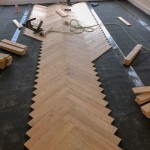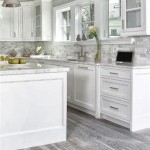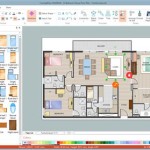Kitchen Cabinet Colors With Dark Floors: A Comprehensive Guide
The combination of dark floors and kitchen cabinets presents a design challenge and opportunity. Dark floors provide a strong grounding element, capable of anchoring a space, while kitchen cabinets offer a substantial vertical surface area for introducing color and personality. Achieving a balanced and aesthetically pleasing result requires careful consideration of color theory, material choices, and the overall design style.
The impact of dark floors should not be underestimated. They can create an intimate, luxurious feel or, conversely, a stark, modern environment. The selection of cabinet colors plays a crucial role in dictating the overall atmosphere of the kitchen. A poorly chosen cabinet color can lead to a space that feels cramped, unbalanced, or visually unappealing. Conversely, a well-chosen color palette can enhance the beauty of the dark floors and transform the kitchen into a welcoming and stylish area.
Understanding The Impact of Dark Floors
Dark floors, whether hardwood, tile, laminate, or other materials, inherently absorb light. This characteristic can make a room feel smaller if not properly balanced with lighter elements. The specific shade of dark flooring, from deep ebony to rich walnut, will also influence the choice of cabinet colors. Ebony floors, for example, demand a greater contrast than walnut floors to prevent the space from becoming overly dark. The texture of the flooring also matters. A matte finish will absorb more light than a glossy finish, which will reflect some light back into the room. Consequently, one must carefully consider these factors when planning the color scheme.
Furthermore, the existing natural light within the kitchen significantly impacts the perception of darkness. Kitchens with large windows and ample natural light can handle darker cabinet colors more effectively than kitchens with limited natural illumination. In the latter case, prioritizing lighter cabinet colors is essential to maximize brightness and prevent the space from feeling enclosed. Artificial lighting also plays a critical role and should be planned thoughtfully to complement both the dark floors and the chosen cabinet colors.
Exploring Cabinet Color Options
The range of cabinet colors that can work with dark floors is extensive, but certain options consistently prove successful. The key is to create sufficient contrast and visual interest. Lighter colors, in particular, tend to work well as they visually counteract the darkness of the floor, brightening the overall space. However, darker cabinet colors can be employed effectively if balanced with lighter countertops, backsplashes, and accessories.
White Cabinets: White cabinets are a classic choice that provides a stark and elegant contrast against dark floors. This combination is versatile and can be adapted to various kitchen styles, from modern minimalist to traditional farmhouse. Different shades of white, from bright white to off-white or cream, can be used to create varying degrees of warmth and visual interest. White cabinets also reflect light, which is particularly beneficial in kitchens with limited natural light.
Gray Cabinets: Gray cabinets offer a sophisticated and modern alternative to white. Lighter shades of gray, such as dove gray or silver gray, create a subtle contrast against dark floors, maintaining a bright and airy feel. Darker shades of gray, such as charcoal gray or slate gray, can be used to create a more dramatic and contemporary look. When using darker grays, it's crucial to incorporate lighter elements, such as white countertops or a bright backsplash, to prevent the space from feeling too dark. The specific undertones of the gray (warm or cool) should also be considered in relation to the undertones of the flooring.
Light Wood Cabinets: Light wood cabinets, such as maple, birch, or light oak, provide a natural and warm contrast against dark floors. This combination creates a welcoming and organic feel, suitable for various kitchen styles, including Scandinavian, contemporary, and transitional. The natural grain patterns of the wood add visual texture and interest. It's important to consider the specific shade and grain pattern of the wood to ensure it complements the dark floors without clashing.
Colored Cabinets: While neutral colors are often the safest bet, colored cabinets can add a unique and personalized touch to the kitchen. Light blue, sage green, or pale yellow cabinets can create a cheerful and inviting atmosphere. Deep blues, greens, or reds can create a more dramatic and luxurious feel. When using colored cabinets, it's essential to consider the overall color palette of the kitchen and ensure that the color complements the dark floors and other design elements. Test paint swatches in the space under different lighting conditions to ensure the color appears as desired.
Two-Toned Cabinets: A two-toned cabinet scheme, where upper and lower cabinets are different colors, is an excellent way to add visual interest and balance to a kitchen with dark floors. Typically, lighter colors are used for upper cabinets to create a sense of height and airiness, while darker colors are used for lower cabinets to ground the space. For example, white upper cabinets paired with gray or navy blue lower cabinets can create a sophisticated and modern look. The choice of colors should be carefully considered to ensure they complement both the dark floors and each other.
Beyond Color: Material and Finish Considerations
The material and finish of the cabinets also play a significant role in the overall aesthetic. Different materials, such as wood, laminate, or metal, will have distinct textures and visual properties that affect how they interact with the dark floors. Finishes, such as matte, gloss, or textured, will also influence the way light is reflected and the overall feel of the kitchen.
Wood Cabinets: Wood cabinets offer a range of options, from classic oak to modern maple. The specific wood species will influence the color and grain pattern of the cabinets. A matte finish on wood cabinets can create a more rustic and natural feel, while a glossy finish can create a more sleek and contemporary look. The choice of finish should be considered in relation to the finish of the dark floors. For example, pairing matte wood cabinets with glossy dark floors can create an interesting contrast.
Laminate Cabinets: Laminate cabinets offer a durable and cost-effective alternative to wood. They are available in a wide range of colors and finishes, including wood-look laminates. Laminate cabinets are easy to clean and maintain, making them a practical choice for busy kitchens. The finish of laminate cabinets can range from matte to high-gloss, offering flexibility in design.
Metal Cabinets: Metal cabinets, such as stainless steel or powder-coated metal, can create a sleek and modern look. They are durable and easy to clean, making them a popular choice for contemporary kitchens. Metal cabinets reflect light, which can help to brighten a space with dark floors. The finish of metal cabinets can range from brushed to polished, influencing the overall aesthetic.
Beyond the primary materials, the hardware selected for the cabinets exerts an influence. Brushed nickel or chrome hardware can complement lighter cabinet colors, while darker hardware, such as matte black or oil-rubbed bronze, can provide a striking contrast against lighter cabinets and further accentuate the dark floors.
Incorporating Countertops, Backsplashes, and Lighting
The choice of countertops, backsplashes, and lighting is essential for complementing the kitchen cabinet colors and dark floors. These elements should be carefully selected to create a cohesive and balanced design. Countertops provide a horizontal surface that breaks up the vertical space occupied by the cabinets, while backsplashes offer an opportunity to introduce texture, color, and pattern. Lighting plays a crucial role in illuminating the kitchen and highlighting the various design elements.
Countertops: Lighter countertops, such as white quartz or light granite, can create a bright and airy feel, contrasting effectively with dark floors and cabinets. Darker countertops, such as black granite or soapstone, can create a more dramatic and luxurious look, particularly when paired with lighter cabinets. The material and finish of the countertops should also be considered. Quartz countertops offer durability and a wide range of color options, while granite countertops provide a natural and unique look. Wood countertops can add warmth and character to the kitchen.
Backsplashes: The backsplash offers an opportunity to introduce color, pattern, and texture. White or light-colored tiles can create a clean and classic look, while colorful or patterned tiles can add visual interest. Glass tiles reflect light, brightening the space. Subway tiles are a popular choice for their versatility, while mosaic tiles can add a touch of artistry. The backsplash should complement both the cabinet colors and the dark floors, creating a cohesive design.
Lighting: Adequate lighting is crucial for illuminating the kitchen and highlighting the design elements. Recessed lighting provides ambient illumination, while pendant lights offer focused lighting over the island or breakfast bar. Under-cabinet lighting illuminates the countertops, making food preparation easier and safer. The type of lighting fixtures and the color temperature of the bulbs should be carefully selected to create the desired atmosphere. Warm lighting can create a cozy and inviting feel, while cool lighting can create a more modern and energetic atmosphere. Consider the placement and intensity of lighting to avoid shadows and ensure sufficient brightness.

Neat Kitchen Color Schemes With Dark Floors

Can I Have Light Kitchen Cabinets With Dark Floors

Can I Have Light Kitchen Cabinets With Dark Floors

What Color Cabinets Go Best With Dark Brown Hardwood Floors

Neat Kitchen Color Schemes With Dark Floors

Dark Brown Hardwood Floors A Guide To Choosing The Perfect Cabinet Color

Choosing The Perfect Cabinet Color For Dark Brown Hardwood Floors

11 Cabinet Colors That Pair Perfectly With Dark Wood Floors

Paint Colors That Go With Dark Wood Floors

What Color Floor Goes With Dark Brown Cabinets Smartflooringtips








